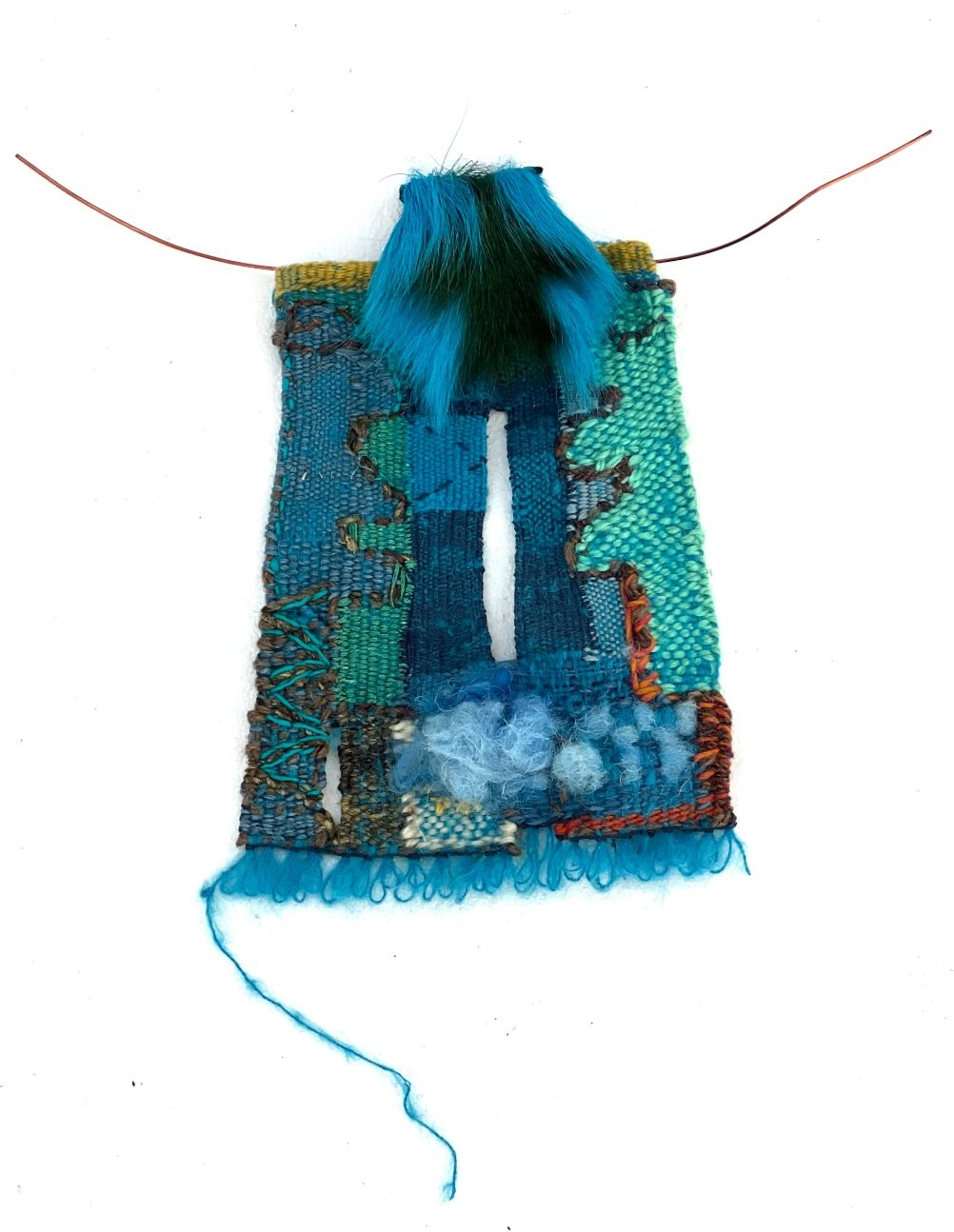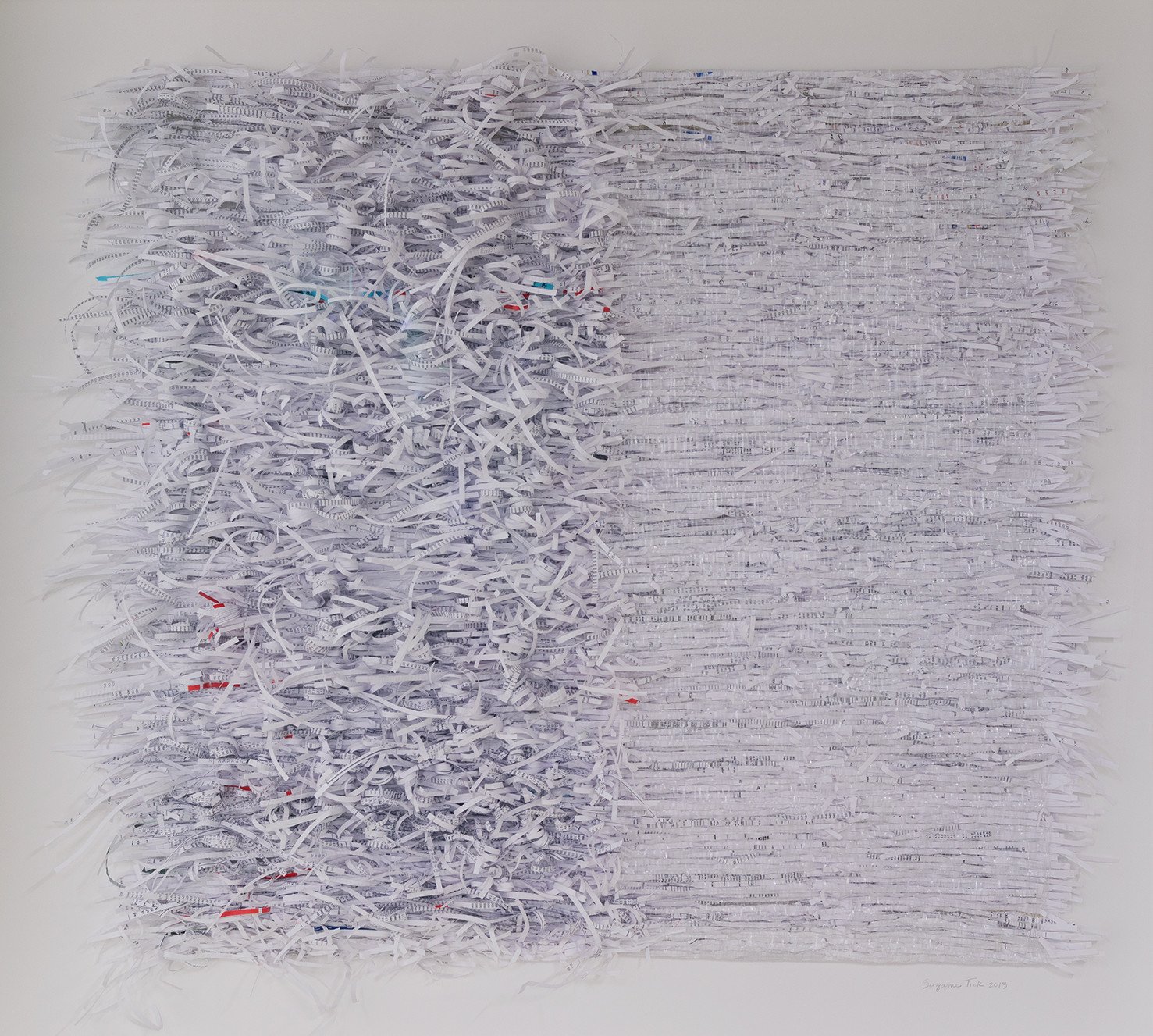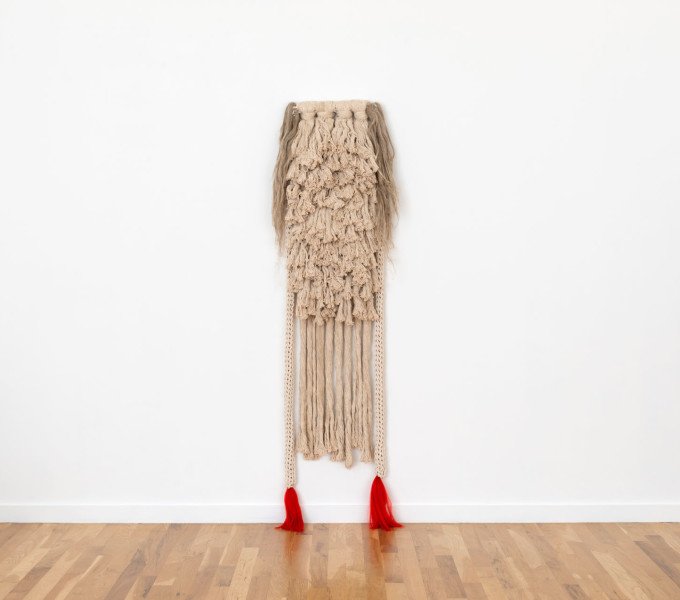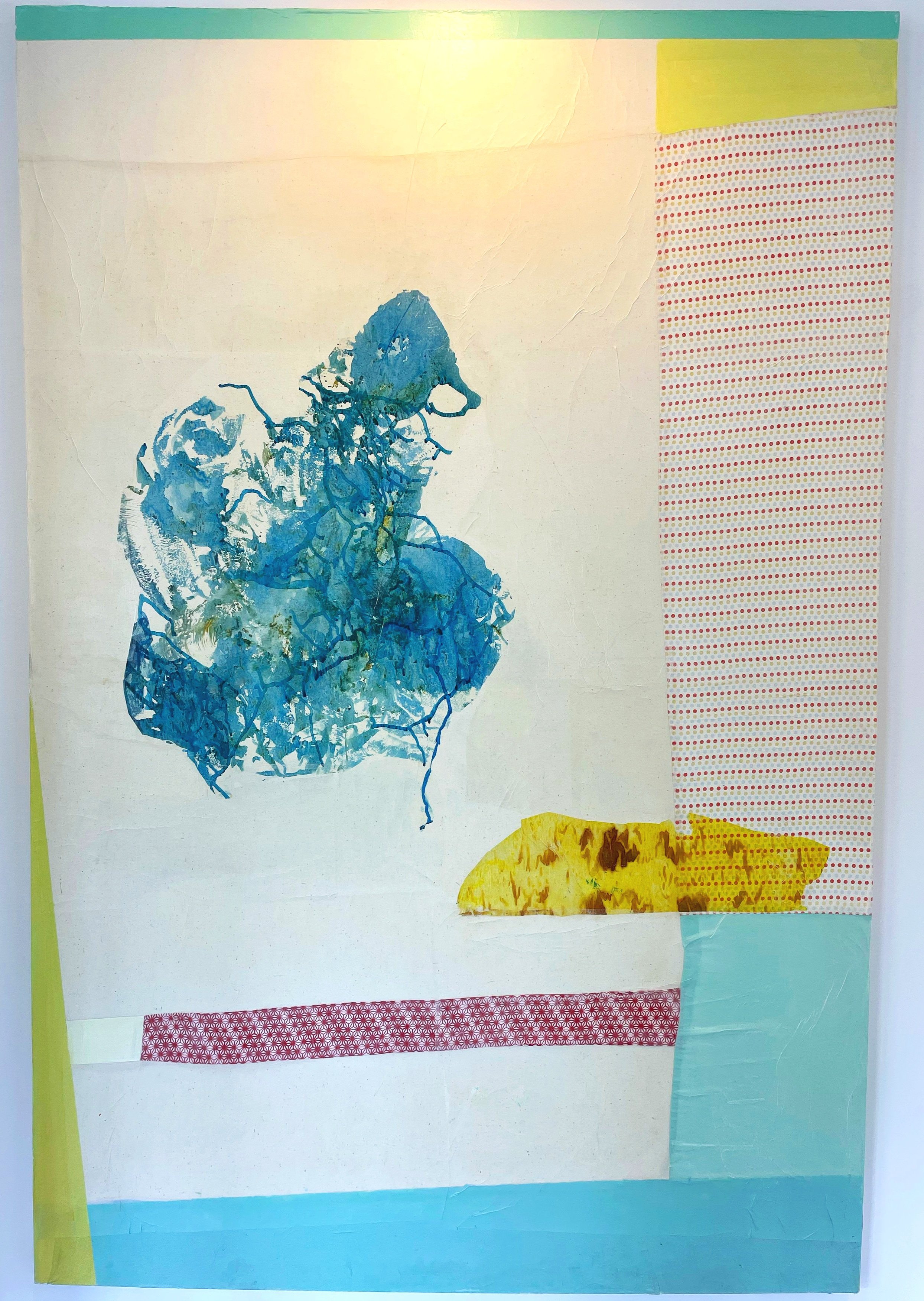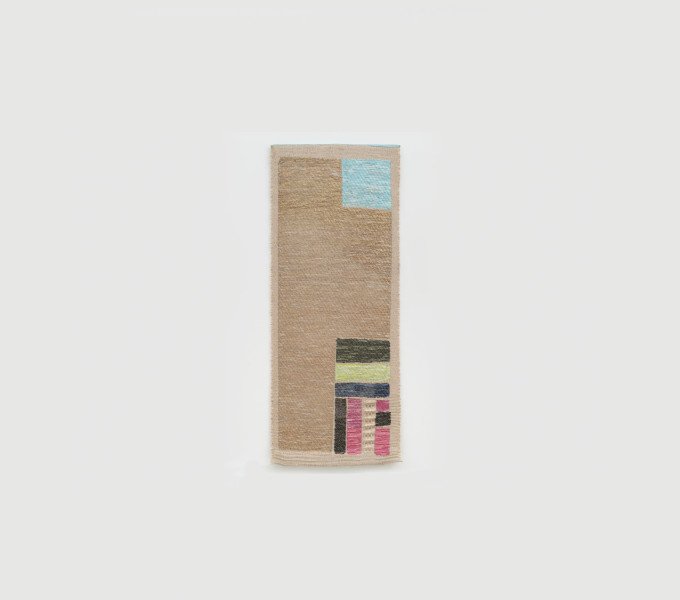A Loom of One’s Own
July 2nd - July 30th, 2022
“A Loom of One’s Own” is an apt title for this show which highlights the work of 11 women artists working in a broad range of medium all-encompassing textiles in some form.
A play on the title of the famous book by Virginia Woolf “A Room of One’s Own” which is a series of six essays seeking to answer why, historically, fewer women than men have written.
We know in art we have the same story. And especially women artists who have worked in textiles were often relegated to craft fairs and looked at as lesser.
Things are changing finally and textiles are having a moment. Great.
We believe in and support women expressing themselves in ALL creative ways.
Lisa says….
“This show is super exciting because of the incredibly innovative ways textiles and weavings appear in art today. From work combining leather, silk, yarn, raw canvas, metal, plastic, neon, mylar and even divorce papers the creativity of these women shows no bounds.”
O Dear ITs down to the Water, Candace Hill-Montgomery
My approach to painting & or weaving is instinctual with abstract drawing being the main focus in both, generally a tree is a tree speaking for itself unless changed abstractly authentically eternally treeing down to paper being.
In my paintings, on paper especially, I can work much more quickly , brush on , wait for oil paint or ink /acrylic to dry being the only definable sigh, wherein even the tiniest weave can take months especially the triangulations' series, ones with triangular openings for triangle shaped metal triangulometers that fit through my requirements to create tiny triangle based sculptures .
It's difficult to get a pictorial gesture using threads even largely out there on a personally designed square loom so I do the pirouette back & forth painting to weave vs versa ; geometric progressions onward to public space. One needs all of these mediums including sculpture to find the right compositional strategy referencing all the thwarted irregularities at play in the twists and turns of any material day .
Sometimes a bright sunny day is everything needed when developing the deep indigo blues of a large splashy cyanotype with attached filmstrip. Whether using the wily employment of pompous paint or teeniest threads a verve twist is exploded fast!
The poet in me either loves painterly slap dash freedom to look at & or express, humorously, the world filtered & transposed through its mirrored reflections, up close, easel height, afar off, hung off, street smart, drooping, draining, dropping, just playing with dripping abstraction' is confirmation that the mind is working, speaking to the cornucopia of making things, back & forth sun rays develop chemicals into an expression out of nowhere, that figural tilt eclipsed by blues colored by gravity's perception of the sunny known & thrown into the,''what's going on'' phrasing as Marvin Gaye would probably say twice with directed brushy focus. Not being too serious, too ironical, too arty 2 boot... I'd here, like to shout out to music for lending me disc flattened late hip hop imagery ... huge is the broken scratched line which never sleeps or fails except when refusing to use the oaring weave with in the oblivious pale atopic! What's love got to do with icky?
His & Hers, Suzanne Tick
Suzanne Tick
Suzanne Tick provides an intelligent perspective and conviction to the ever-evolving design industry. A fourth-generation recycler, Tick’s life work is centered around exploring new materials and reinventing manufacturing methods. Her textiles signify an effortless union between her age-old weaving techniques and the latest technology, solidifying her as a master of her craft. From the beginning, Tick spent summers in her father’s scrap recycling yard sorting metals and exploring the possibilities in the cast-offs of rural life. At the University of Iowa, Tick began as a printmaker, etching fabric and texture onto copper plates. She left as a weaver, combining materials both hard and soft. Tick’s life and work have always been a narration of balance and her woven works harness the struggles of life, resulting in textiles that are both delicate and strong. She investigates found materials. As Tick states, “weaving holds everything together, materials and life, successes and failures.”
Her recent commissions explore innovation through transformation of refuse materials into woven sculptures with deep personal meaning. Her work has been exhibited in MoMA, Cooper Hewitt, MAD and Art Basel, as well as collected by private and corporate clients. Suzanne’s TedXNavesink Talk: “Weaving Trash into Treasure” presents her unique and personal approach to hand weaving.
Extraño 8, Tanya Aguiñiga
Tanya Aguiñiga
Tanya Aguiñiga (b. 1978) is a Los Angeles-based artist/designer/craftsperson who was raised in Tijuana, Mexico. She holds an MFA in furniture design from Rhode Island School of Design and a BA from San Diego State University. In her formative years, she created various collaborative installations with the Border Arts Workshop, an artists' group that engages the languages of activism and community-based public art. Her current work uses craft as a performative medium to generate dialogues about identity, culture, and gender while creating community. This approach has helped Museums and non-profits in the United States and Mexico diversify their audiences by connecting marginalized communities through collaboration.
Aguiñiga is a 2022 Latinx Artist Fellow, a recipient of the 26th annual Heinz Award, a United States Artists Target Fellow in the field of Crafts and Traditional Arts, a NALAC Grant Recipient, and a Creative Capital 2016 Grant Awardee. She is the inaugural fellow for Americans for the Arts Johnson Fellowship for Artists Transforming Communities. She has been the subject of numerous articles in American Craft Magazine and has been featured in Art21’s Art in the Twenty-First Century, KCET’s Artbound, and PBS's Craft in America Series. Aguiñiga is the founder and director of AMBOS (Art Made Between Opposite Sides), an ongoing series of artist interventions and commuter collaborations that address bi-national transition and identity in the US/Mexico border regions. AMBOS seeks to create a greater sense of interconnectedness while simultaneously documenting the border.
Carnival, Amy Wickersham
I am interested in looking closely at surfaces, intrigued by what may be unseen or overlooked, the space between what is perceivable and what is implied. Fragments of forms that are embedded below, or floating above reveal themselves as the painting progresses. My work portrays these forms, both found and imagined, drawing inspiration from my observations in nature or in an urban environment. Using a variety of materials, such as dyed silk, paint, and plaster, layering, scraping off, painting over, the surface builds. As I explore color, texture, and composition, the paintings evolve through the meeting of structure and fluidity, balancing the space between intuition and intention - therein lies the sweet spot.
May I Make a Suggestion, Claire Watson
My work as a sculptor is based on the use of found objects and repurposed materials. Concurrent series often develop in tandem, like separate but related trains of thought. The most recent works are all constructed from salvaged and disassembled leather clothing. I preserve the pattern parts as found shapes, and employ hand sewing and self-taught tailoring techniques to combine them into stretched canvas panels. I’m intrigued by the material properties of leather, by the embedded content of its human and animal histories, and by the clothing pattern shapes because of the ways they reflect the curves and scale of the human form in abstraction.
Untitled, Toni Ross
The first of a new typology series, this work searches for a new language, as our current vocabulary continues to fail us. As evidenced by my previous work, I have long been interested in the aesthetics of written communication: the rhythm of words on a page, a piece of bark, a stone, a blackboard. Inspired by cuneiform, hieroglyphs, and other ancient writing, this work pays homage to the abstract beauty of the written word. Modern influences, like the geometric, elegant lines of Carl Andre’s sculptures and Bice Lazzari’s typed drawings can also be found in the overall composition
Horizontal Dreaming, Mitsuko Asakura
As an artisan in the textile arts of Japan, Asakura moved beyond the craft of dyeing to the art of tapestry weaving. She articulated her artistic vision in her book, Listening to the Thread (1994). She says of her work: “The structure of weaving is comparable to that of pointillism in painting. Colors never really mix together in textile, they keep their distinct colors and fresh transparency under light.”
Topography, Bastienne Schmidt
Bastienne Schmidt is a multi-disciplinary artist working with photography, painting and large-scale drawings. She was born in Germany, raised in Greece and Italy and has lived in New York for the past 30 years.
Her artwork is included in the collection of the Museum of Modern Art, the International Center of Photography, the Brooklyn Museum, the Victoria and Albert Museum in London and the Bibliothèque Nationale in Paris, among others. Her work has been shown nationally and internationally in over 100 exhibitions, among them the International Center of Photography in New York, the Brooklyn Museum, the New Museum, the Museum fuer Kunst und Gewerbe in Hamburg, among many others. She has published seven monographs, among them Vivir la Muerte, American Dreams, Shadowhome, Home Stills, Topography of Quiet, Typology of Women and Grids and Threads.
Field of Gold, Christy Matson
Christy Matson
Christy Matson begins her weavings with a sketch, collage, or watercolor that she translates into complex pixelated images to be woven on a computerized Jacquard loom. Matson paints, spray paints, or dyes the majority of fibers that make up her work and manually weaves the materials into the loom, giving her control over every inch of the work. Her work is both gestural, reflecting the quick compositions they begin as, and geometric, due to the ubiquitous weaving patterns like twill and waffle weave that she deploys. Matson pushes these iterative structures to their limits, often using substantial shifts in scale in either the warp or weft to achieve rich, dimensional surfaces. She works primarily with materials that are surplus or deadstock, recently working through a limited quantity of un-spun Japanese paper yarn.
Matson’s painterly explorations of surface and structure reference the concept of the grid as well as historic woven patterns like ticking stripes, gingham, subtle florals, and overshot—patterns with rich and varied histories from handlooms to textile factories. Each piece is a unique blend of handmade and digital elements, a captivating combination of optical and tactile properties.
Pan Demos All People, Saskia Friedrich
Saskia Friedrich
The small fabric works are two of a series in ‘Untitled (pan demos-all people)’. I was working during the pandemic and contemplating the interconnectedness of all of us as human beings inhabiting our world, the interconnectedness of each other and all of the living systems of planet earth. These ‘paintings’ unfold the space of interconnection. The idea of unity of all being that is unfolding into myriad complexities.
The hanging outdoor work ‘Untitled’ is playing with ideas of outdoor sculpture as an intervention in the natural world that can help us relate and see with a sense of renewal our environs. What if it was a giant fruit or a very large chrysalis hanging there. We are at play with the eye of the mind.
Patterson, Mary Little
“Patterson pays homage to Mary Little’s latest series, Lineage, expanding on the themes found in its predecessor, Alexander. The double layers complement each other in their distinction, with the flat, orderly rows beneath holding a steadiness for the three furrowed, fluted panels that wander against it. Their waved edges interact in a way that draws attention to the pattern found within the folds. Think structure meets serendipity. At the top, all connect through a long, quiet row, giving both panels an anchor from which to freely let go."
Late Summer, Madoo, Laurie Lambrecht
Laurie Lambrecht

